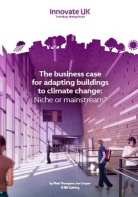The business case for adapting buildings to climate change
On 2 June 2015, at the Vision Conference in London, Innovate UK (previously the Technology Strategy Board) launched the final report of the Design for Future Climate: Adapting Buildings (D4FC) programme, 'The business case for adapting buildings to climate change: Niche or mainstream?' by Matt Thompson, Ian Cooper and Bill Gething. The launch of the full report followed publication of an Executive Summary in November 2014.
The report is the culmination the 4-year D4FC programme which included work by 240 companies and generated a body of evidence about how buildings exposed to climate risks can be adapted. It responds to the Government's National Adaptation programme and considers adaptation to climate change at the scale of individual buildings.
The report is based on the observations from a designers group and a client's group and assesses the key drivers affecting the market for design services to adapt buildings in preparation for a changing climate. In the foreword, Mark Wray, Lead Technologist in the Built Environment team at Innovate UK suggests that, “The subject is complex and full of uncertainties, but for firms who respond it seems likely that there will be early adopter commercial advantages as climate hazards become more prevalent and as pressure on clients to consider adaptation grows. Properly managed and exploited, the momentum gained should put the UK at the forefront of the dawning international market for adaptation services in the built environment, which grew by over 5% last year.”
The report proposes that the challenge is to optimise building design for a phased transition to anticipated future needs, making use of maintenance cycles for upgrades. It sets out seven key messages:
- The market for design services to adapt buildings to future climate change remains very limited.
- The limited market is not an excuse for building design professionals to do nothing.
- Construction clients risk procuring stranded assets.
- The government must signal that adaptation in the built environment is a critical issue.
- At present, the construction and property industries have no adaptation plan to tackle climate change.
- Clients and professionals urgently need educating in climate change adaptation for buildings.
- There is a need for a programme of monitoring and evaluating the performance of climate adapted buildings.
It suggests that lack of willingness by clients to engage with the problem dampens designers motivation and reduces the scope for the market to develop, but the report identifies mounting pressure on clients from the insurance industry, investment institutions and financial stakeholders.
Recommendations include:
- Developing construction client decision-making tools.
- Updating standard terms and conditions to account for climate change adaptation services.
- Developing a protocol for assessing the risk to buildings from climate change hazards.
- Develop computational tools to standardise the way that climate change projections are used by designers.
- Updating standards, planning and building regulations to accommodate climate change adaptation, including the use of future weather data in the building regulations at their next revision.
- Public procurement and maintenance regimes considering future climate change and the development of buildings with adaptive capacity.
- Establishing a programme of research to reduce the uncertainty of future climate impacts on the built environment at the local site-based scale.
[edit] Find out more
[edit] Related articles on Designing Buildings Wiki
- Building engineering physics.
- Energy targets.
- Environmental policy.
- Green deal.
- Greenhouse gases.
- Hex House project.
- Innovate UK.
- Kyoto protocol.
- Stranded assets.
- Sustainability.
- Sustainable materials.
- The Carbon Plan: Delivering our low carbon future.
- The Low Carbon Transition Plan: National strategy for climate and energy.
- UK Climate Change Risk Assessment.
- Zero carbon homes.
- Zero carbon non-domestic buildings.
Featured articles and news
RTPI leader to become new CIOB Chief Executive Officer
Dr Victoria Hills MRTPI, FICE to take over after Caroline Gumble’s departure.
Social and affordable housing, a long term plan for delivery
The “Delivering a Decade of Renewal for Social and Affordable Housing” strategy sets out future path.
A change to adoptive architecture
Effects of global weather warming on architectural detailing, material choice and human interaction.
The proposed publicly owned and backed subsidiary of Homes England, to facilitate new homes.
How big is the problem and what can we do to mitigate the effects?
Overheating guidance and tools for building designers
A number of cool guides to help with the heat.
The UK's Modern Industrial Strategy: A 10 year plan
Previous consultation criticism, current key elements and general support with some persisting reservations.
Building Safety Regulator reforms
New roles, new staff and a new fast track service pave the way for a single construction regulator.
Architectural Technologist CPDs and Communications
CIAT CPD… and how you can do it!
Cooling centres and cool spaces
Managing extreme heat in cities by directing the public to places for heat stress relief and water sources.
Winter gardens: A brief history and warm variations
Extending the season with glass in different forms and terms.
Restoring Great Yarmouth's Winter Gardens
Transforming one of the least sustainable constructions imaginable.
Construction Skills Mission Board launch sector drive
Newly formed government and industry collaboration set strategy for recruiting an additional 100,000 construction workers a year.
New Architects Code comes into effect in September 2025
ARB Architects Code of Conduct and Practice available with ongoing consultation regarding guidance.
Welsh Skills Body (Medr) launches ambitious plan
The new skills body brings together funding and regulation of tertiary education and research for the devolved nation.
Paul Gandy FCIOB announced as next CIOB President
Former Tilbury Douglas CEO takes helm.
UK Infrastructure: A 10 Year Strategy. In brief with reactions
With the National Infrastructure and Service Transformation Authority (NISTA).























